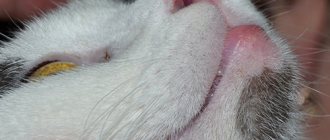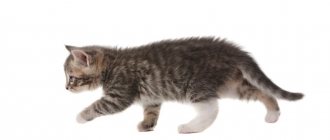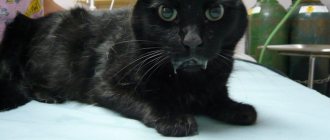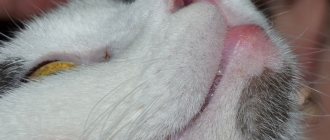In many situations, cat owners know what causes this or that deviation in their pet’s health. But in some cases it is difficult to determine the cause on your own, because there are many of them. This also applies to cases where a cat has a swollen lower lip.
Before visiting the veterinarian, you should remember what the cat has been doing in recent days, how she spent her time, and whether she went outside. It would not be amiss to note changes in the animal’s behavior that have taken place recently. When communicating with a veterinarian, this data can be useful: with their help, the cause of the tumor will be established as accurately as possible.
Probable Causes
Edema and swelling of the lower lip may be associated with the following disorders and diseases:
- Jaw injuries.
- Inflammation of the gums.
- Allergy.
- Neoplasms.
- Infection of the mucous membranes of the lips.
The principle of treatment depends on the cause of the swelling. It is necessary to observe the behavior of your pet in order to be able to make a diagnosis. Swelling after injuries appears almost immediately, a few hours after the injury.
If the pet falls or hits itself, and then swelling of the cat’s lower lip appears, the cause is injury. In this case, it is necessary to apply a cold compress to reduce the swelling and examine the lower jaw. In severe cases, surgery cannot be avoided.
Treatment of the disease
If a cat has a swollen lower lip, the therapeutic effect depends entirely on the cause that caused this phenomenon. Below we consider methods of treating this problem depending on its pathogenesis:
- If this happened because the cat was switched to dry food, then simply change her diet and the problem will disappear in 5-6 days by itself.
- For injuries and burns, smear the affected area with such effective remedies as Levomekol, Sangel, Sanatol, Ranosan. They can be used both in the form of powders or gels, and in the form of ointments or sprays.
- If the owner suspects that the reason is an allergic reaction to something, then it is permissible to give him Suprastin.
- Oncological neoplasms are treated as follows: malignant - with chemotherapy and strong painkillers, benign - with surgical intervention.
- The fungus can be eliminated by such products as Fungivet-cream, Zoomikol, Imaverol.
- Inflammation with viral etiology is affected by Camedon, Anandin, Kanamycin.
- Lincomycin, Sinulox, and Levamisole have performed well in the fight against infections.
Each of the above drugs can only be prescribed by a doctor, based on the general condition of the cat, its age and weight. Do not self-medicate under any circumstances, this will only aggravate the problem and cause more suffering to your mustachioed friend.
Finally, I would like to say that neither a kitten nor an adult cat is immune from the occurrence of such a phenomenon. There are a lot of reasons for this. Therefore, it is important to take your pet for examination to a doctor and, based on the recommendations received, carry out therapeutic therapy. Otherwise, the pet may die.
Inflammation of the gums and dental pathologies
Dental diseases are very often accompanied by slight swelling of the lip border and oral mucosa. The most common cause of enlargement of the lower lip is gingivitis - inflammation of the gums. The causes of gingivitis are weakened immunity, mucosal injury, and food allergies.
Characteristic symptoms:
- bad breath;
- red border around teeth;
- loss of appetite;
- increased saliva production;
- swelling of the gums and lips.
Older animals or cats whose bodies are weakened by a long-term illness are more likely to experience gingivitis. This disease requires treatment as it can lead to tooth loss.
Gingivitis is treated with medication, using topical agents. As a rule, special gels or ointments with an antibiotic and an anti-inflammatory component are prescribed. Plaque must be cleaned and tartar removed. Additionally, medications are prescribed to enhance immunity.
Diagnosis of eosinophilic granuloma in cats
An accurate diagnosis requires a thorough clinical examination of the animal by a specialist and, in some cases, analysis of the affected tissue - microscopic examination (cytology). In the initial stage of development, according to a clinical blood test, the doctor notes an increase in blood cells - eosinophils. Based on the results of cytology, granuloma is differentiated from diseases that are very similar in clinical picture - bacterial and fungal skin lesions, as well as neoplasms (tumors) of the skin and mouth. Special tests exclude fleas and ticks - a wet test to identify fleas and scrapings from the surface of the skin to exclude ticks.
The cat's lower lip is swollen photo
Treatment of eosinophilic granuloma in cats
To effectively treat eosinophilic granuloma, the treating doctor must identify and take control of the primary cause of its appearance. To reduce relapses (repeats), it is important to treat the primary disease that led to the formation of granuloma. Treatment with antiparasitic drugs or the animal may need to be placed on a special diet (diet treatment may take about 6-8 weeks). Sometimes treatment simply requires removing contact with the allergen and using local treatments is sufficient. Symptomatic treatment of eosinophilic granuloma itself should be aimed at reducing itching and inflammation, for this purpose glucocorticosteroids (for example, prednisolone) are used. The doctor selects dosages individually for each animal. Improvements can be observed already in the first 2-4 weeks. As soon as the skin begins to heal, the dose of the drug (prednisolone) is gradually reduced. In some cases, fairly long-term use of the drug in minimal doses is required (for example, with atopic dermatitis). In chronic and advanced forms, the affected skin becomes contaminated with bacteria, which requires additional use of antibiotics and longer treatment. For an accurate diagnosis and speedy recovery of your pet, when the first signs of the symptoms listed above appear, immediately consult a veterinarian.
Allergy
Another common cause of swelling is an allergic reaction. Swelling and redness of the mouth can be caused by:
- Reaction to insect bites.
- Food allergies.
- Contact dermatitis.
Most often, severe swelling develops from insect bites. The venom of wasps, bees and some types of spiders is a strong allergen, which, when it enters the body, triggers an immunopathological process. Symptoms of insect sting allergy:
- presence of signs of a bite;
- swelling of the skin around the bitten area;
- itching and burning;
- hyperemia and hyperthermia of the skin.
These are symptoms of a common allergic reaction that occurs without complications. In acute allergies, anaphylaxis or Quincke's edema may develop. This is dangerous due to the spread of swelling to the larynx and paralysis of the respiratory tract, which leads to death. Angioedema requires immediate medical attention.
An acute allergic reaction can be recognized by the rapid increase in symptoms. An allergy to insect bites always develops literally a few minutes after the poison enters the animal’s body.
If a cat's lower lip is swollen after changing its diet, it is a sign of food intolerance. This allergy develops slowly as the irritant accumulates in the body. This is manifested by swelling and redness of the rim of the mouth, itching, spots on the ears and around the nose.
Contact dermatitis is a type of allergic reaction that develops as a result of the action of an irritant on the skin. It occurs when household chemicals, medications, or cat cleaning products come into contact with the area around the mouth. The disorder is manifested by skin hyperemia, swelling, itching. The cat becomes restless and scratches the area around its mouth until it bleeds.
In case of allergic reactions, the first thing to do is to interrupt contact with the irritant. If you have food intolerance, you should change the food; if you have dermatitis, you should cleanse the skin of any remaining irritant. Then the animal is given antihistamines, ointments and gels for allergies can be used.
Why is my cat's lip swollen?
The fact that the lip is swollen means that something is causing inflammation in or around the lip. Many things can cause inflammation. Swelling is a common immune system reaction that the body produces in response to many insults. The swelling itself is usually caused by the release of white blood cells and fluids into the area, which rush to try and solve the problem. Let's look at some of the most common things that can cause swollen lips:
© shutterstock
- Injury
Cats are famous for their sophistication and elegance, but experience tells us that they often get into accidents, scratches, fights and blows. Sometimes they lack common sense! It is not uncommon for cats to be injured head first, and the injury can result in damage to the lips.
Both the injury and any subsequent infection can lead to swollen lips. Usually the lips are swollen in one place, and there may be other sores around the head, ears and neck. It's worth checking your cat's claws—scuffed and damaged claws are a good sign that your cat has been through something violent!
Symptoms
A swollen lip over a couple of days, which your cat may lick or clean excessively, often shows up as sores or swelling on other parts of the head. The lip will likely look angry and painful when touched. There may be discharge or pus from the swollen area, and cats may drip from one side of the mouth. Otherwise, your cat will be healthy and relaxed.
- Bites or reactions
This is usually more of a dog problem as dogs like to stick their head into things, but cats can also suffer from a reaction to something like a sting or nettle. For example, if a cat was chasing and trying to eat a bee or wasp, a bite to the mouth may cause the lips to swell. These are allergic reactions, but they are usually mild. More serious allergic reactions (known as hives or anaphylaxis) are rare but possible. Again, the lips will likely be swollen in only one place, although swelling may be everywhere.
Symptoms
Sudden appearance (within a few hours) of a swollen lip - Your cat may hold her mouth open and pant heavily or harshly. There may be tumors or bumps on the rest of the body. Sometimes the whole head swells! Your cat will be hypersensitive and agitated, often dripping heavily from the mouth. There will usually be no discharge from the swollen area, but you may see a small brown bee or wasp sting - try brushing it off with a light touch of your finger if you can do so safely.
- Oral or dental disease
Cats are prone to oral and dental diseases. They are known as gingivitis or stomatitis, depending on which parts they affect and how severe they are. Like all animals, cats suffer from tooth decay, tartar, and plaque, but in cats they can become much more complex and sinister than in other species due to the interaction between several factors in the mouth—bacteria, viruses (especially calicivirus), and the immune system itself.
While plaque and tartar progress slowly in most animals, cats can have massive, inappropriate reactions to the bacteria and viruses that live in the mouth, causing enormous inflammation even when the teeth appear fairly clean and healthy. This can even cause the teeth to begin to sink back into the jawbone! As you can imagine, this disease is really painful and unpleasant, just like mouth pain for us.
Symptoms
Slowly progressive swollen lips (several days to weeks or more) in several places, especially at the corners of the lips. The swelling will gradually increase along with other symptoms. Your cat may be slow or reluctant to eat, especially avoiding crunchy hard objects. You may have noticed that he has bad breath.
If you see your cat's teeth, you will notice severe redness in the gums around some or all of the teeth, and red spots may appear on the tongue and roof of the mouth. Your cat may clean and lick, and a small amount of fluid may come out of the mouth. You may notice blood in the water bowl after your cat has had a drink.
© shutterstock
- Autoimmune diseases
Autoimmune diseases are generally rare in all species. In humans, rheumatoid arthritis is a good example of how troublesome these problems can be. Essentially, the immune system incorrectly attacks or damages some part of its own body.
Cats suffer from a special group of diseases called eosinophilic granuloma complex, known as EGC or as indolent ulcers or rodent ulcers. They are not well understood and can vary, but essentially there is an influx of white blood cells called eosinophils into a specific area of the skin. The attack often occurs in the mouth, lips or throat, but can occur anywhere on the cat's body. This surge of cells causes pain, swelling, severe inflammation, discharge and, surprisingly, can also become infected! They come in three main types, but can be very different from cats.
EGC often has no clear cause, but has been associated with various factors that can trigger the immune system, including food intolerances, allergies to parasites such as flea or mosquito bites, or something in the environment (such as pollen) and viruses ( especially feline immunodeficiency virus (FIV).
Symptoms
Swelling on the skin or mouth appears fairly quickly (within a few days) and can be very itchy and painful. The ulcers affect the upper lip and palate - they are raised, red, angry and fairly well defined at the edges. Other types of EGC appear as raised, irritated patches of skin that are yellow/pink in color, painful, and weeping with discharge. Cats are otherwise generally well, but feel discomfort and may have difficulty eating. They may groom themselves excessively and dribble the ball.
- All the rest
This list is by no means exhaustive, and there are many reasons why cats may develop a swollen lip. Regardless of the reason, if you are concerned about your cat, you should seek professional, qualified care from a veterinarian as soon as possible. Only a veterinarian can properly diagnose and treat these problems to ensure the correct solution is provided to your cat as soon as possible.
© shutterstock
How to prevent the problem
It is easier to prevent a disease than to cure it later - this rule is familiar to every person. Therefore, it is recommended to carefully monitor the well-being and health of your pet in order to be able to provide the necessary assistance in a timely manner and, perhaps, even save the life of your beloved cat.
A well-chosen diet depending on the age and physiological needs of the animal, keeping it in conditions that meet the standards, proper care and hygiene, timely vaccination and scheduled visits to the veterinarian will help prevent the development of many diseases that are typical for most representatives of the cat family.










